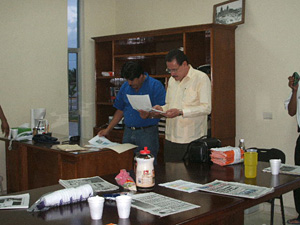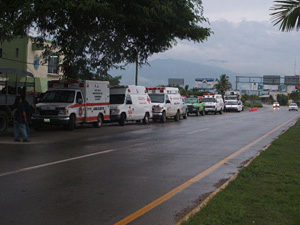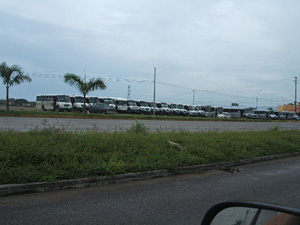 |
 |
 |
 News from Around Banderas Bay | September 2006 News from Around Banderas Bay | September 2006  
Emergency Mobilization For No-Show John
 Harold Sokolove - PVNN Harold Sokolove - PVNN


| | Drs Estrada y Cuevas.jpg - In preparation for Hurricane John, Banderas Bay Director of Civil Protection, Dr. Claudio Estrada, and Bahia de Banderas President Dr. Jaime Cuevas, worked with local and governmental agencies to create an emergency action plan. | 
| | About 15 emergency response officials remained nearly non-stop until Estrada declared the emergency over on Friday morning, | 
| | Thirty-five buses from the ATM and Compostela bus companies were lined up and ready to be deployed in case evacuations were necessary anywhere in the Banderas Bay municipality. |
John, meet Claudio. That would be Hurricane John and Dr. Claudio Estrada, the Director of Civil Protection for the Bahia de Banderas on Banderas Bay's north shore in Nayarit State.

There wasn't much Claudio could do about John's temperamental attitude, considering the hurricane ultimately decided to swish by this section of the Mexican coast and target Los Cabos instead. But it wouldn't keep the doctor from trying to be prepared for a potentially disastrous visit sometime during the last week in August.

Many people probably remember well the events leading up to and during the days when Hurricane Kenna slammed the Puerto Vallarta area coastline in October, 2002, the first hurricane to hit the area in over 50 years.

Part of Estrada's job is to always keep a watchful eye on computer communications from other governmental agencies.

Early on in hurricane John warnings, Estrada received an urgent notification from CENAPED, the Mexican National Center for Prevention of Natural Disasters. It's akin to the US National Weather Service, issuing weather bulletins of impending dangerous weather conditions which could affect life and property.

Estrada was informed that John was on a course to affect the Puerto Vallarta area. Almost immediately, meetings with other officials in the neighboring State of Jalisco, to coordinate activities and to share resources, started taking place.

The President of the Bahia de Banderas, Dr. Jaime Cuevas, was notified by Estrada that the area was in potential danger and received the response, "What do you need?"

With that approval to move forward, Estrada created an operativa, or action plan, for the Bahia de Banderas. It called for the coordination of personnel and activities from about one dozen different emergency and governmental agencies.

About 200 people were on alert. Personnel from the military, Cruz Roja, private ambulance companies, fire fighters, and public works officials from as far away as Tepic, the Capital of Nayarit, about 200 km away, were contacted. Ambulances and fire trucks were staged in key areas across the municipality.

It's a massive task to put together this kind of a plan, especially on such short notice. Bahia de Banderas covers an area of over 775 square kilometers from Lo de Marcos on the north to the Ameca River on the south and as far inland as the village of Aguamilpas. It comprising numerous cities, towns and villages and terrain ranging from farmland to mountains. Communication is difficult to say the least.

Estrada immediately turned his office on the second floor of the fire station in Jarretaderas into a Hurricane Command Center, where about 15 emergency response officials remained nearly non-stop until Estrada declared the emergency over on Friday morning, after reviewing the most current weather information and speaking face-to-face with President Cuevas.

Makeshift sleeping arrangements were made throughout the fire station. In fact, some personnel called in from outlying areas were forced to sleep in their trucks, while they stood by for further orders.

One interesting scene that turned the heads of drivers passing by on Hwy 200 were the 35 buses from the ATM and Compostela bus companies that were lined up in the graded area at the north entrance to Nuevo Vallarta. The buses were ready to be deployed if evacuations from anywhere in the municipality were called for.

Throughout the entire process, Cuevas was kept informed of the developing situation, so that immediate approval could be granted for any additional emergency response.

According to Estrada, the cost of this operation is going to be borne entirely by the municipality, and that will amount to about 1 million pesos.

Without a doubt, it was money well spent. | 
 | |
 |



